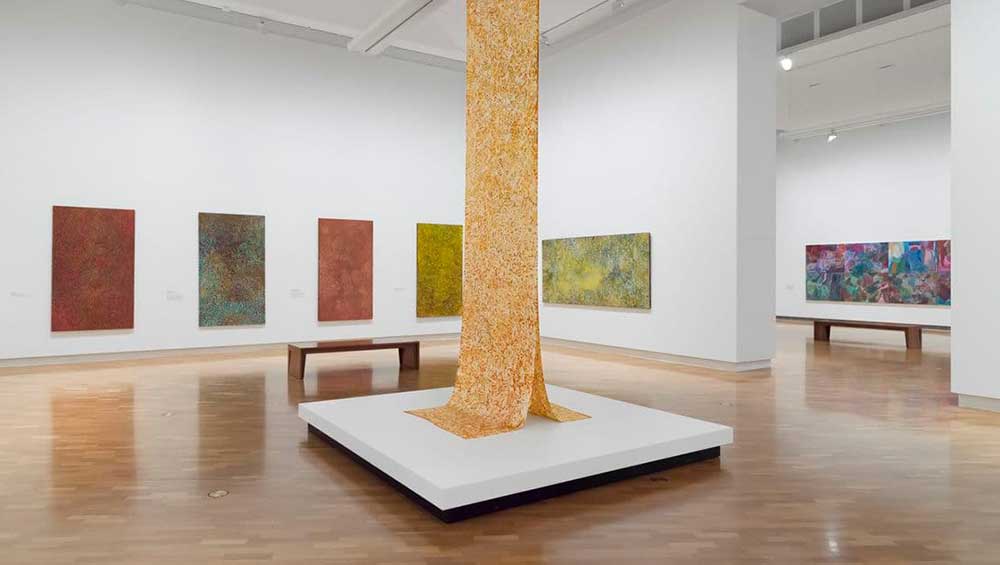
Installation view, Emily Kam Kngwarray, National Gallery of Australia, Kamberri/Canberra, 2023. Photo: Jed Cooper.
National Gallery of Australia, Canberra
2 December 2023 – 28 April 2024
by JANET McKENZIE
It is more than 25 years since the Australian Indigenous artist Emily Kam Kngwarray died, yet the capacity of her work to draw crowds and inspire awe has not diminished. In 2008, at the National Museum of Australia, the exhibition, Utopia: The Genius of Emily Kame Kngwarreye (the alternative spelling of her name), which had opened in Japan (Tokyo and Osaka), was spectacular in scale and content. The power of the show was unlike any other exhibition I have seen: the unique phenomenon of an elderly female artist from the central desert of Australia, who produced 3,000 paintings was unprecedented. There was an intense physicality in the encounter, at once immersive and inexplicable. I reviewed it for Studio International in an optimistic spirit, noting the transformation that had been made in the status and aknowledgement of Indigenous culture in Australia in the two decades that led up to the international recognition of one of the country’s greatest artists. Against the heinous conditions experienced by Aboriginal Australians historically, the 2008 exhibition came to be equated with the apology of the then prime minister, Kevin Rudd, on 13 February that year, for the government practices surrounding the Stolen Generations.1
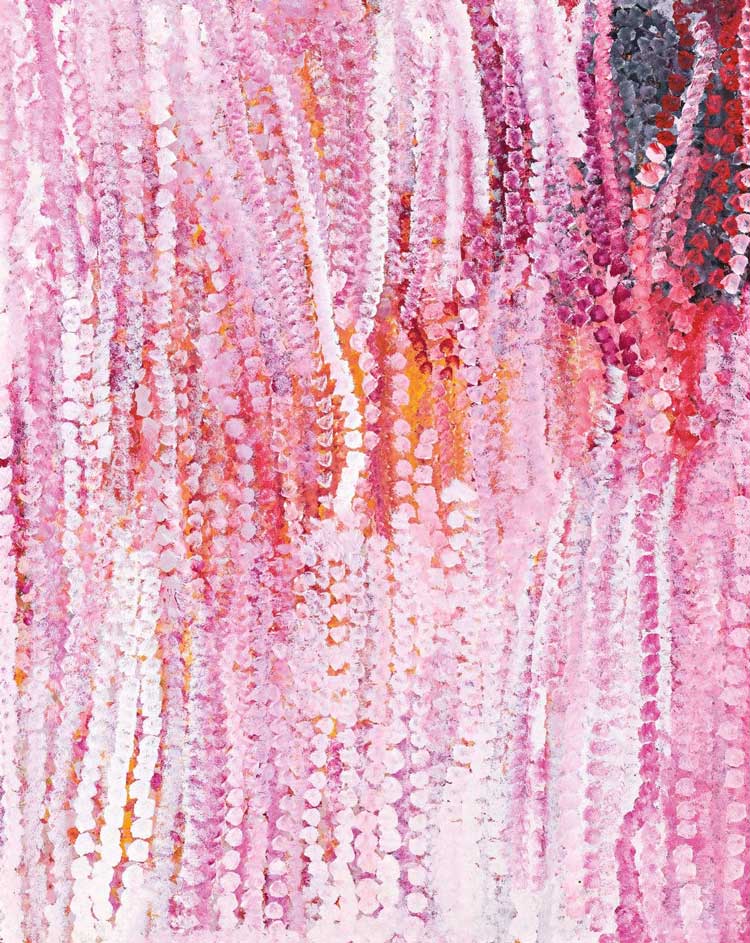
Emily Kam Kngwarray, Anmatyerr people, Alhalker Country, 1994. Private collection, Naarm/Narrm / Melbourne © Emily Kam Kngwarray / Copyright Agency, 2023. Image courtesy of Deutscher and Hackett.
Emily Kam Kngwarray opened at the National Gallery of Australia less than two months after the referendum in which the Australian electorate voted against changing the constitution to recognise the First Peoples of Australia by establishing a body called the Aboriginal and Torres Strait Islander Voice. I had been looking forward to the new show, excited to see a vast body of Kngwarray’s paintings again, and, indeed, entering the exhibition was an uplifting experience, the sheer beauty and spiritual power of the works that is so difficult to describe, consistently incredible. There is a transcendence achieved in the painted works on canvas – and in her early batik works on silk – that enables the viewer to connect with the spirit of the Australian landscape, the spiritual bond the First Nations people have with Country.
In preparation for the exhibition, the curators, Kelli Cole (Warumungu and Luritja peoples) and Hetti Perkins (Arrernte and Kalkadoon peoples), lived in Alice Springs for almost two years, working closely with Kngwarray’s family and their community. Their abiding message is that, as an Aboriginal artist, Kngwarray has to be seen to be of her community. Referring to her by her western name, Emily, undervalues the relationship with her past and with her community. Even when she became an internationally acclaimed artist, she never lived alone, but remained with her family and community members.
,-1989.jpg)
Emily Kam Kngwarray, Anmatyerr people, Ankerr (emu), 1989. National Gallery of Victoria, Naarm / Narrm / Melbourne, purchased from Admission Funds, 1990 © Emily Kam Kngwarray / Copyright Agency, 2023. Image courtesy of National Gallery of Victoria, Naarm / Narrm / Melbourne.
Viewing Aboriginal art through a western lens has been misleading and inaccurate, yet Kngwarray’s art, in batik and acrylic on canvas, was enabled by female anthropologists who sought to encourage communities of women to make art, following the Papunya Tula initiative in the early 1970s that was strictly for men. The introduction of workshops to teach batik art in the 70s and 80s was key in dispelling patriarchal misconceptions about Aboriginal art. Early anthropological data tended to separate the “secular” or “profane” pursuits of women from the “sacred” rites of men, which were in turn made manifest in their art. As a consequence, women’s work was confined to the decoration of craft objects that accompanied their main activities in relation to the female duties of breeding and cooking, and they were not given access to art materials such as canvas. The batik programme led to some of the most remarkable Aboriginal art of the past 20 years.
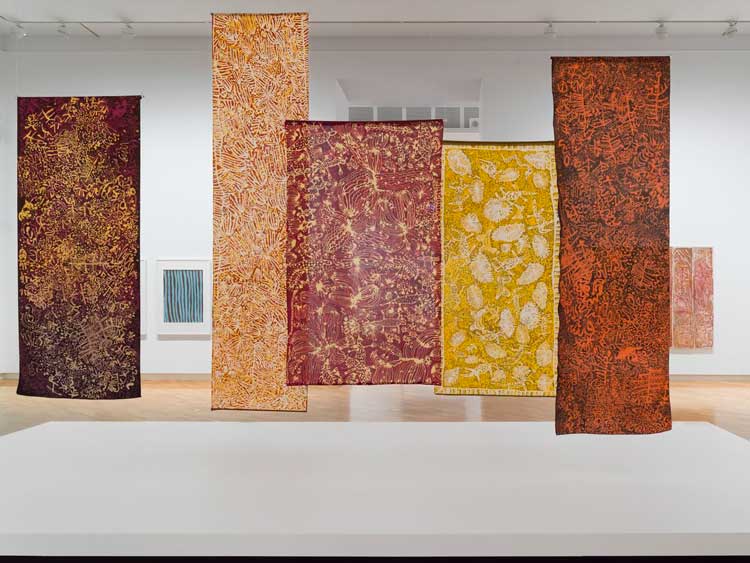
Installation view, Emily Kam Kngwarray, National Gallery of Australia, Kamberri/Canberra, 2023. Photo: Jed Cooper.
The batik works hang in the first three rooms of the new exhibition, establishing context for her visual art. The gentle movement of the batik works as banners act on the imagination in a particularly evocative manner. It was high summer in Canberra when I visited in January; the floating fabric pieces conjure the dramatic and harsh climate of the central desert where the works were made. The exquisite patterning and layers of finely created images of her country are captured from an aerial viewpoint characteristic of Aboriginal desert art: the emu (ankerr) markings, pencil yam (anwerlarr) and fan flower (intekw) are mesmerising. The catalogue is an exemplary production with excellent essays and beautiful photographs, with the input of linguistic scholar Dr Jennifer Green, enabling the words of Kngwarray herself (and those of family members and other artists) to give precise insight into the artist’s practice.
Kngwarray was born in about 1914 and lived in the Sandover region, north of Alice Springs. A year after her death in 1996, her work was shown at the 1997 Venice Biennale, with Judy Watson (Waanyi) and Yvonne Koolmatrie (Ngarrindjeri). Such recognition placed her at the height of international contemporary art. The meaning and cultural power of her art, for her and her family, is still at odds with its understanding and reception in the marketplace and in the context of art and its histories. She only took up painting in her 60s, using the medium of batik. Eleven years later she was supplied with acrylic paint and canvases, and it was in this latter part of her life that she produced the 3,000 paintings. Her international success and unique career trajectory were met with awe, and viewing works such as Yam Awely (1995) again, the rare thrill has not diminished. The new exhibition and catalogue enable further insight into the meaning and significance of art for the artist and her community, a devotional process to life cycles and life forces, of Country.
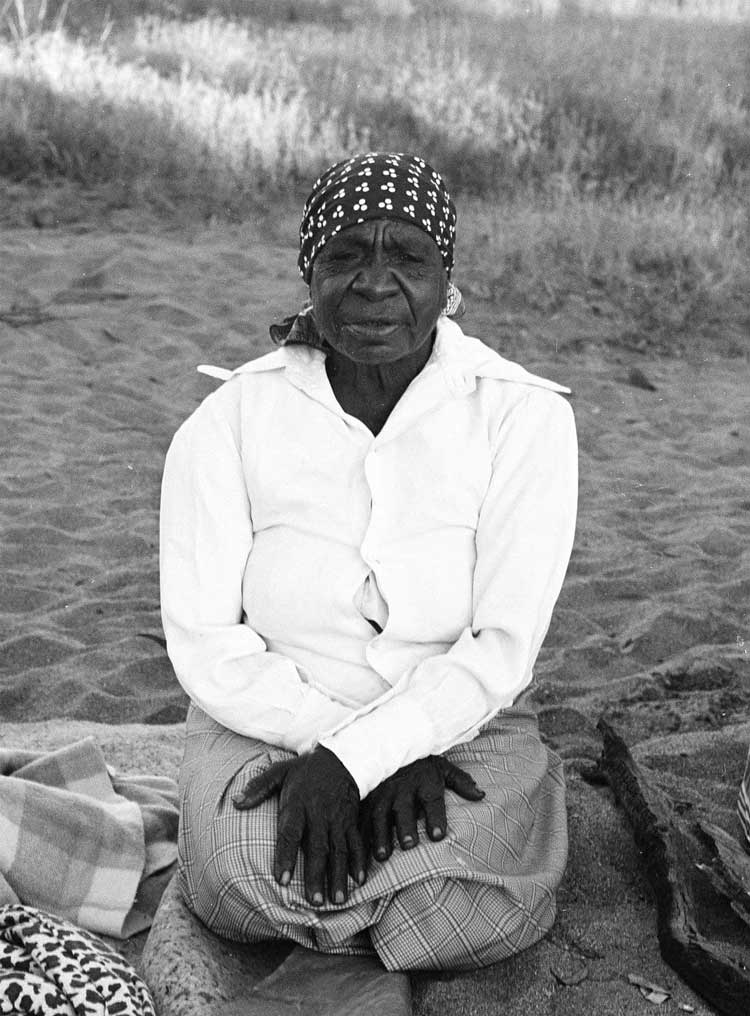
Emily Kam Kngwarray near Mparntwe / Alice Springs after the first exhibition of Utopia batiks, 1980. Photo: © Toly Sawenko, 2023.
The artist’s family have been involved in the exhibition and the accompanying film. Descendants Jedda Kngwarray Purvis and Josie Petyarr Kngwarray suggest: “If you close your eyes and imagine the paintings in your mind’s eye, you will see them transform. They are real – what Kngwarray painted is alive and true. The paintings are dynamic and keep on changing, and you can see how realistic they are … The Country transforms itself, and those paintings do as well. That’s why the old woman is famous.”

Emily Kam Kngwarray, Anmatyerr people, The Alhalker suite, 1993. National Gallery of Australia, Kamberri / Canberra, purchased 1993. © Emily Kam Kngwarray / Copyright Agency.
In 2025, the exhibition will travel to Tate Modern in London. How the scholarly repositioning of Kngwarray, by the NGA’s curators, will be received in London is concerning after Australia in 2013 at the Royal Academy, the most comprehensive exhibition of Australian art to have been mounted there, was treated with ignorant contempt. One hopes that Kngwarray’s exquisite work will be better appreciated. The vast scale and beauty in works such as the 22-panel landscape The Alhalker Suite (1993) evoke a sense of the enormity of country and faith in creation and a restorative future. The black and white Big Yam Dreaming (1995) is also spectacular and massively inspiring. One hopes that Kngwarray’s profound oeuvre and life story will resonate as a message of hope. It is phenomenal that such a profound vision was created by a woman in her 80s, who had only taken up painting on canvas in her 70s. It is a truly beautiful exhibition.
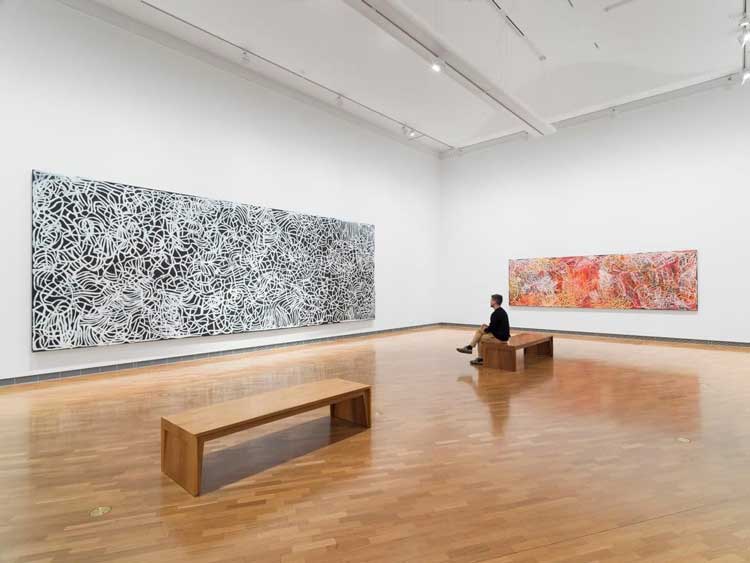
Installation view, Emily Kam Kngwarray, National Gallery of Australia, Kamberri/Canberra, 2023. Photo: Jed Cooper.
Reference
1. A Rape of the Soul So Profound by Peter Read, published by Allen & Unwin: Sydney, 1999: page 169.